- Clone
- 8F4 (See other available formats)
- Regulatory Status
- RUO
- Other Names
- BTLA, B and T lymphocyte attenuator
- Isotype
- Mouse IgG1, κ
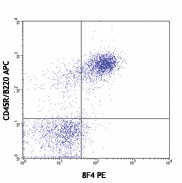
-

C57BL/6 splenocytes stained with 8F4 PE and CD45R/B220 APC -

C57BL/6 splenocytes stained with mouse IgG1 PE isotype control and CD45R/B220 APC
| Cat # | Size | Price | Quantity Check Availability | ||
|---|---|---|---|---|---|
| 134803 | 25 µg | $134.00 | |||
| 134804 | 100 µg | $360.00 | |||
B and T lymphocyte attenuator (BTLA) is an Ig superfamily coinhibitory receptor with structural similarity to programmed cell death 1 (PD-1) and CTLA-4. BTLA is expressed on B cells, T cells, macrophages, dendritic cells, NKT cells, and NK cells. Engagement of BTLA by its ligand Herpes Virus Entry Mediator (HVEM) is critical for negatively regulating immune response. The absence of BTLA with HVEM inhibitory interactions leads to increased experimental autoimmune encephalomyelitis severity, enhanced rejection of partially mismatched allografts, an increased CD8+ memory T cell population, increased severity of colitis, reduced effectiveness of T regulatory cells. BTLA takes an important role in the induction of peripheral tolerance of both CD4+ and CD8+ T cells in vivo. Tolerant T cells have significant up-regulated expression of BTLA compared with effector and naïve T cells. BTLA may cooperate with CTLA-4 and PD-1 to control T cell tolerance and autoimmunity. It was reported that BTLA may regulate T cell function by binding to B7-H4. But further studies are needed to confirm. The existence of three distinct BTLA alleles was reported. The BTLA antibody reacts with mouse BTLA from both BALb/c and C57BL/6 strains.
Product Details
- Verified Reactivity
- Mouse
- Antibody Type
- Monoclonal
- Host Species
- Mouse
- Immunogen
- C57BL/6 BTLA Ig domain protein in CFA
- Formulation
- Phosphate-buffered solution, pH 7.2, containing 0.09% sodium azide.
- Preparation
- The antibody was purified by affinity chromatography, and conjugated with PE under optimal conditions.
- Concentration
- 0.2 mg/ml
- Storage & Handling
- The antibody solution should be stored undiluted between 2°C and 8°C, and protected from prolonged exposure to light. Do not freeze.
- Application
-
FC - Quality tested
- Recommended Usage
-
Each lot of this antibody is quality control tested by immunofluorescent staining with flow cytometric analysis. For flow cytometric staining, the suggested use of this reagent is ≤ 1.0 µg per million cells in 100 µl volume. It is recommended that the reagent be titrated for optimal performance for each application.
- Excitation Laser
-
Blue Laser (488 nm)
Green Laser (532 nm)/Yellow-Green Laser (561 nm)
-
Application References
(PubMed link indicates BioLegend citation) -
- Hurchla MA, et al. 2005. J. Immunol. 174:3377
- Product Citations
-
- RRID
-
AB_1731884 (BioLegend Cat. No. 134803)
AB_1731884 (BioLegend Cat. No. 134804)
Antigen Details
- Structure
- An Ig superfamily coinhitory receptor with structural similarity to programmed cell death 1 (PD-1) and CTLA-4.
- Distribution
- BTLA is expressed on a wide number of lymphocytes in mice. It is most highly expressed on B cells, followed by CD4+T cells, lower express on CD8+ T cells, macrophages, dendritic cells, NKT cells, and NK cells.
- Function
- BTLA functions as a negative regulator of T cell activation and proliferation. It attenuates B cell proliferation upon associating with its known ligand, Herpes Virus Entry Mediator (HVEM).
- Ligand/Receptor
- Herpes Virus Entry Mediator (HVEM)
- Cell Type
- Lymphocytes, B cells, T cells, Dendritic cells, NKT cells
- Biology Area
- Immunology, Inhibitory Molecules
- Molecular Family
- CD Molecules
- Antigen References
-
1. Liu X, et al. 2009. J. Immunol. 182:4516
2. Miller ML, et al. 2009. J. Immunol. 183:32
3. Sun Y, et al. 2009. J. Immunol. 183:1946
4. Vendel AC, et al. 2009. J. Immunol. 182:1509
5. Watanabe N, et al. 2003. Nat. Immunol. 4(7):670
6. Sedy JR, et al. 2005. Nat Immunol. 6(1):90 - Gene ID
- 208154 View all products for this Gene ID
- UniProt
- View information about CD272 on UniProt.org
Other Formats
View All CD272 Reagents Request Custom Conjugation| Description | Clone | Applications |
|---|---|---|
| PE anti-mouse CD272 (BTLA) | 8F4 | FC |
| Alexa Fluor® 647 anti-mouse CD272 (BTLA) | 8F4 | FC |
| APC anti-mouse CD272 (BTLA) | 8F4 | FC |
Compare Data Across All Formats
This data display is provided for general comparisons between formats.
Your actual data may vary due to variations in samples, target cells, instruments and their settings, staining conditions, and other factors.
If you need assistance with selecting the best format contact our expert technical support team.
-
PE anti-mouse CD272 (BTLA)
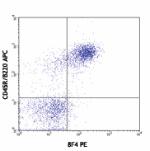
C57BL/6 splenocytes stained with 8F4 PE and CD45R/B220 APC 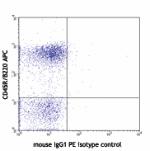
C57BL/6 splenocytes stained with mouse IgG1 PE isotype contr... -
Alexa Fluor® 647 anti-mouse CD272 (BTLA)
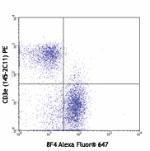
C57BL/6 splenocytes stained with 8F4 Alexa Fluor® 647 an... 
C57BL/6 splenocytes stained with Alexa Fluor® 647 mouse ... -
APC anti-mouse CD272 (BTLA)
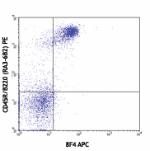
C57BL/6 mouse splenocytes stained with 8F4 APC and CD45R/B22... 
C57BL/6 splenocytes stained with mouse IgG1 APC isotype cont...
